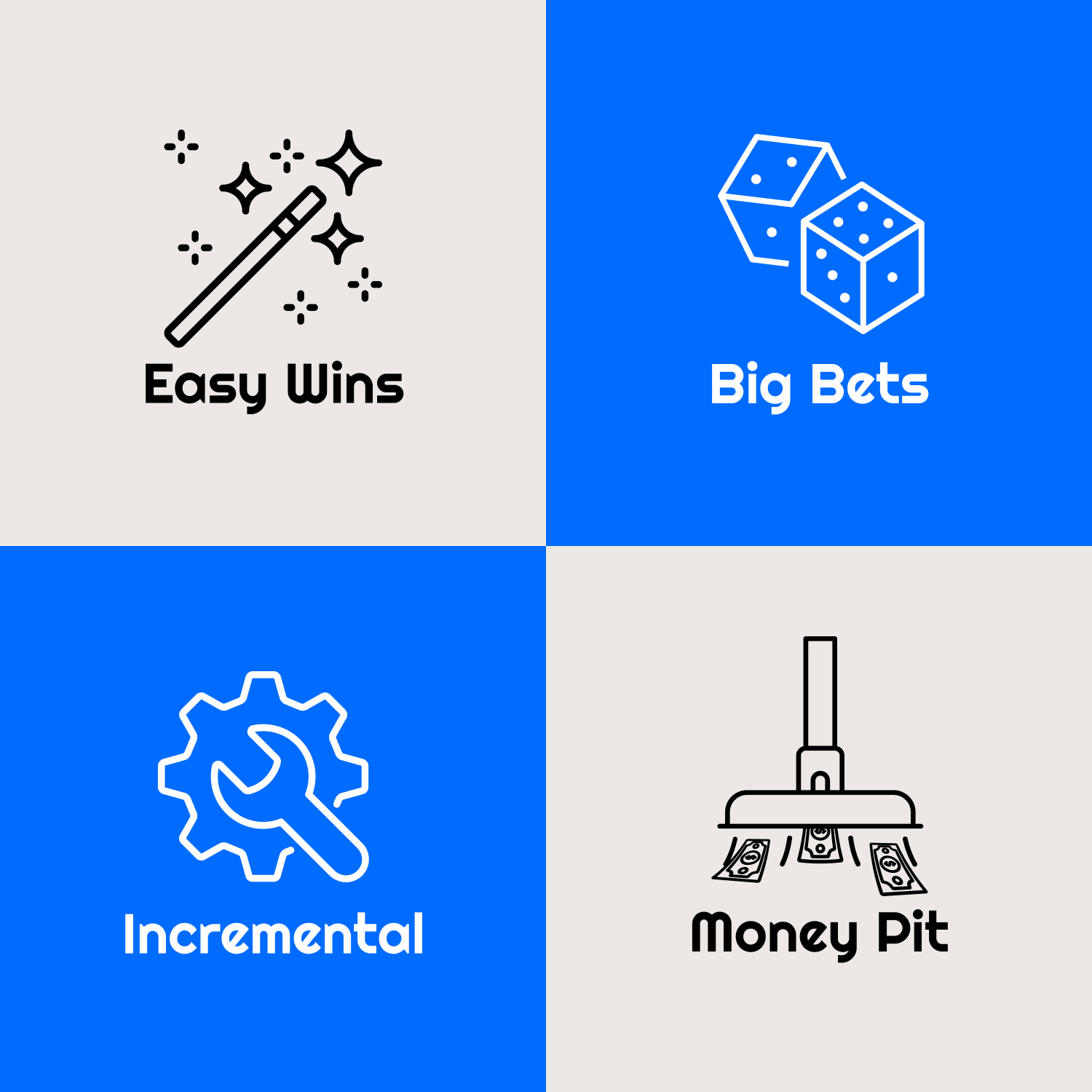When it comes to improving customer experience (CX), organizations often feel pulled in a dozen directions. Should you focus on updating your website, launching a new loyalty program, or streamlining your onboarding process? It’s easy to get overwhelmed or waste resources on initiatives that don’t deliver meaningful results. That’s where the Effort vs. Impact Matrix comes in.
This straightforward tool helps you sort through your options and prioritize what really matters. By identifying high-impact, low-effort initiatives—your Quick Wins—you can create immediate value while keeping long-term goals in sight. Let’s get into it.
What is an Effort vs. Impact Matrix?
The matrix is a visual tool that evaluates potential projects based on two key factors:
- Effort: How much time, resources, and collaboration will the project require?
- Impact: How significantly will the initiative improve customer satisfaction, retention, or other critical goals?
 The structure of the matrix is a 2x2 grid, which maps initiatives into four categories:
The structure of the matrix is a 2x2 grid, which maps initiatives into four categories:
- Easy Wins: Low effort, high impact. These are the priority—they deliver big results with minimal investment.
- Big Bets: High effort, high impact. Worth pursuing but require strategic planning and significant resources.
- Incremental Gains: Low effort, low impact. Useful for filling gaps in your schedule but shouldn’t take focus from higher-value work.
- Money Pits: High effort, low impact. Avoid unless there’s a strong justification to proceed.
Using this tool and this approach ensures your team focuses on initiatives that drive the most value for your customers while avoiding wasted time and resources.
Why CX Teams Need an Effort vs. Impact Matrix
In customer experience, prioritization is critical. CX leaders are often tasked with juggling customer feedback, executive expectations, and technology investments. Without a clear decision-making framework, it’s easy to lose sight of what really moves the needle. Here are some tips on how to get started:
Step-by-Step: How to Apply the Matrix to CX Initiatives
List Potential Initiatives
Start by gathering ideas from across your organization. Common CX projects might include:
- Improving website navigation for better usability.
- Launching a customer education video series.
- Automating post-purchase emails for faster feedback collection.
- Redesigning your loyalty program to offer more personalized rewards.
- Upgrading live chat software to include AI-driven suggestions.
Define "Effort" and "Impact"
Effort can include factors like time, budget, and cross-departmental collaboration. Impact should tie directly to key CX goals—think NPS scores, customer retention rates, or time-to-resolution metrics.
Map Your Projects
Using a simple scoring system (e.g., 1-5 for effort and impact), plot each project on the matrix. Tools like FigJam, Miro, Lucidchart, or even sticky notes on a whiteboard can make this exercise collaborative and visual.
Prioritize for Action
Focus first on Quick Wins to create immediate value, then allocate resources for Big Bets. Incremental Gains can be handled during downtime, while Money Pits should be tabled or reconsidered.
Easy Wins (Low Effort, High Impact)
- Example: Adding a live chat widget to your website. It’s easy to implement and provides immediate, personalized support, reducing customer frustration and increasing conversions.
- Why It Works: Minimal technical setup delivers a big boost in responsiveness and customer satisfaction.
Big Bets (High Effort, High Impact)
- Example: Overhauling your CRM to integrate with all customer touchpoints, providing a seamless, personalized experience.
- Why It Works: This requires significant effort but unlocks transformative opportunities for automation, personalization, and insights.
Incremental Gains (Low Effort, Low Impact)
- Example: Sending a monthly thank-you email to long-time customers.
- Why It Works: It takes little effort and helps maintain positive customer relationships, though the impact is more subtle.
Money Pits (High Effort, Low Impact)
- Example: Building a custom app for a small subset of your customers who already engage with your website.
- Why It Doesn’t Work: The cost and complexity outweigh the potential benefits, especially if existing channels already meet customer needs.
Tips for Using the Matrix Effectively
- Bring in Diverse Perspectives: Engage teams from marketing, customer support, and IT to get a well-rounded view of effort and impact.
- Use Data to Guide Decisions: Validate assumptions about impact with customer feedback, analytics, or past performance data.
- Reassess Regularly: Priorities and resources change. Revisit the matrix quarterly to ensure it reflects current goals and constraints.
- Start Small with Big Bets: Break high-effort projects into manageable phases to minimize risk and secure early wins.
The Takeaway: Prioritization for Better CX
The Effort vs. Impact Matrix isn’t just a productivity tool—it’s a way to focus your customer experience efforts on what truly matters. By prioritizing Quick Wins and strategically pursuing Big Bets, organizations can make meaningful progress without burning out their teams or budgets. Whether you’re optimizing a single touchpoint or reimagining your CX strategy, the matrix ensures your resources are used wisely.
Ready to transform your customer experience? Contact us to learn how we can help you identify your Quick Wins and create a smarter, more impactful CX strategy.
